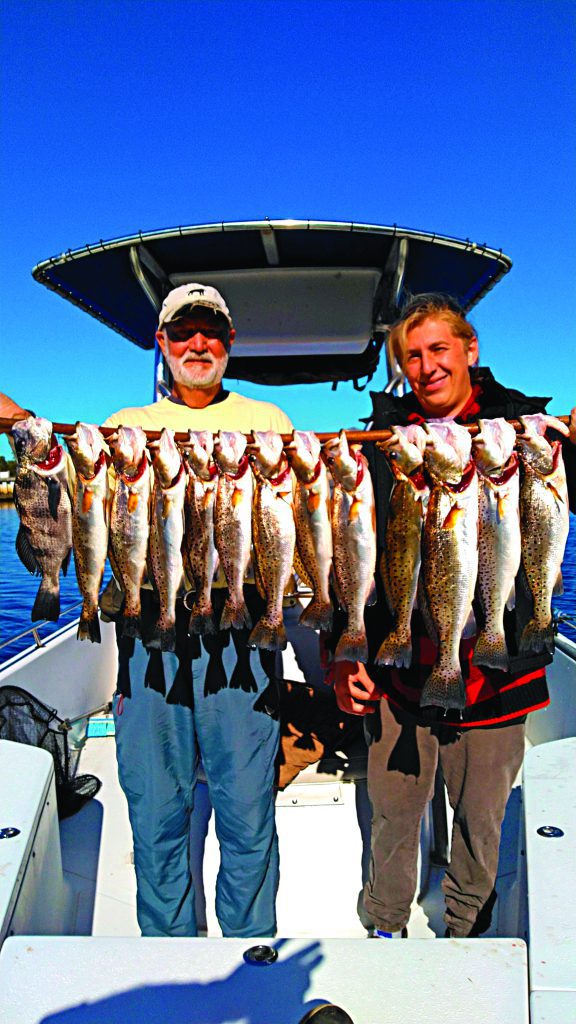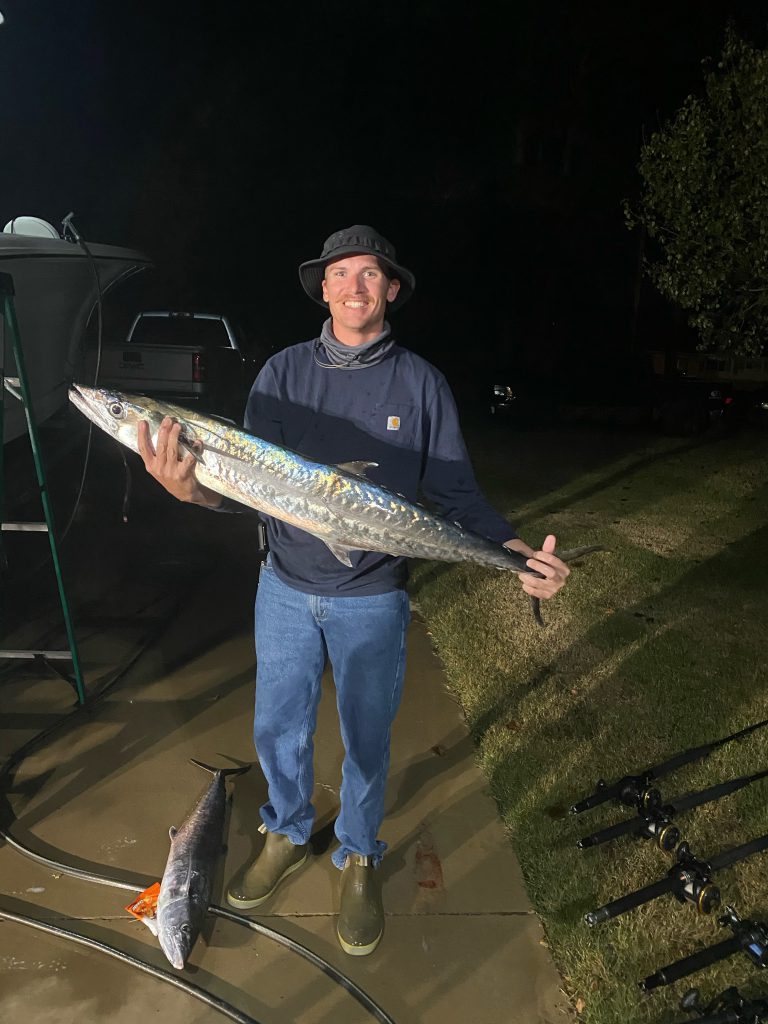Southport/Oak Island – March 2021
Angie, of Dutchman Creek Bait and Tackle, reports that fishing has been slow due to a combination of low water temperatures and unfavorable weather. Over the next few weeks, anglers look forward to major changes, as weather patterns start to stabilize moving into March.
Pufferfish are generally the first species to arrive along the beaches, and they could be arriving any day now.
Whiting start to mix in with the puffers around the same time frame. Bottom rigs with shrimp, bloodworms, or artificial bait strips will be productive setups.
Speckled trout haven’t gone anywhere, but the cold water temperatures have the action slow. With the water starting to change, these schools will start to feed more actively. Look for bites from holes in the back of creeks to areas with structure near the waterways.

Terry Littrell (left) and grandson Robert, of Lake Waccamaw, with a stringer of speckled trout and black drum. The fish were caught using live bait while fishing near Bald Head Island with Capt. Greer Hughes of Cool Runnings Charters.
Josh, of Oak Island Sporting Goods, reports that whiting have been the best bite happening in the surf. Anglers are finding some keeper-sized fish (on the smaller side of keeper) by using Fishbites and fresh shrimp on double drop rigs. The puffer bite in the surf has started and should improve very shortly with warming water temps.
Inshore, the best bet has been red drum in the creeks. The reds are hitting both bait mullet and soft plastics, such as Z-Man and Gulp, and the best areas to target are the deeper holes in the creeks.
The trout bite never truly materialized this winter, but with water warming and the rainwater moving out, the specks should begin to get much more active.
Off the beach, the only reports of late have been black sea bass near and around the Towe.
Wally, of Oak Island Fishing Charters, reports that inshore anglers are focused in on the black and red drum that held over in the area. These fish are extremely hard to pin down with the frigid water temperatures, but over the next few weeks, deploying more natural baits (live or dead shrimp) can help get bites.
Speckled trout fishing has been a bit slow, with most reports coming from anglers fishing north of the region. Anglers expect to see more trout mixed in the counts as the coming weeks see more bait move into the area.
Off the beach, the bite is on for the large class of black sea bass that people love to target. Many nearshore structured areas are holding the sea bass, but it has taken moving to find the larger class.
King mackerel will be moving in over the next few weeks. The first reports of action will be from deep structure (40 mile range).
Gulf Stream anglers are just waiting for the right weather window to target wahoo and blackfin tuna.
Mark, of Angry Pelican Charters, reports that bottom fishing has remained good even with low water temperatures being found out in the Gulf Stream. A mix of the larger black sea bass and vermilion snapper are providing most of the action.
With surface temperatures hovering around 58 degrees out to the 50+ mile mark, even the king mackerel are pushed offshore. Going into the next few weeks, a little bump into the 60s should see the kings move back in over structure.
Offshore trolling is producing some wahoo and blackfin tuna. Going later into March, it is very possible to see a run of yellowfin tuna similar to seasons past.

Bailey Watts, of Supply, with a king that was caught on a cigar minnow while fishing in about 80′ of water offshore of Southport.
Ryan, of Fugitive Charters, reports that anglers look forward to a slight uptick in water temperatures over the next few weeks to bring some life back to nearshore waters.
Bottom fishing anglers will be some of the first to see action changes, with large black sea bass and a few grouper holding in the 50’ depth range.
King mackerel will begin to push back in with the temperature changes, holding over structure out near the Tower.
Gulf Stream anglers hope to see an early flurry of dolphin towards the end of March, if the warmer waters push closer in and define a break.
And if conditions fall into place, bonito may show up over nearshore ARs and structure around this same time.
Ocean Crest Pier is closed for the winter and will reopen in spring.
Oak Island Pier is closed for the winter and will reopen in spring.





